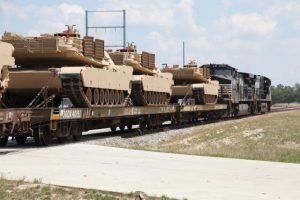 MIL-STD-810G covers Rail Impact in Method 526. Method 526 is new to 810G and the purpose of this test method is to replicate the railroad car impact conditions that occur during the life of transport of systems, subsystems and units, and the tiedown arrangements during the specified logistic conditions. Method 526 is short at 7 pages.
MIL-STD-810G covers Rail Impact in Method 526. Method 526 is new to 810G and the purpose of this test method is to replicate the railroad car impact conditions that occur during the life of transport of systems, subsystems and units, and the tiedown arrangements during the specified logistic conditions. Method 526 is short at 7 pages.
Method 526 is also not intended for testing small, individually packaged material that would normally be shipped when mounted on a pallet or as part of a larger shipment. It is intended for testing items such as tanks, trucks, etc., that are transported by rail.
The rail impact test is intended to test materiel that will be transported by rail; to determine the effect of railroad car impacts that may occur during rail shipment, to verify the structural integrity of the materiel, to evaluate the adequacy of the tiedown system and the tiedown procedures, and to assess transportability1 by the Military Surface Deployment and Distribution Command Transportation Engineering Agency (SDDCTEA). All items are to be tested at their maximum gross weight (fully loaded) rating unless otherwise specified in the transportability requirements for the materiel.
Subjecting materiel to a lab shock test or performing an analytical simulation does not eliminate the requirement to conduct a rail impact test.
Method 526 is not intended for railcar crash conditions.
Effects of Rail Impact
Rail impact shock has the potential for producing adverse effects on the physical and functional integrity of transported materiel. The following are examples of problems that could occur when materiel is exposed to the rail impact environment.
- Loosening of tiedown straps.
- Failure of attachments, creating a safety hazard.
- Shifting of materiel on the railcar.
- Failure of materiel.
- Structural failure.
- Fuel spills.
Testing
Tests are performed with rail cars.
Loaded cars are preferred for use as the buffer or struck cars. However, empty cars may also be used. In either case, the total weight of the buffer cars is to be at least 113,400kg (250,000 lb). The first buffer car must be a standard draft gear car. The remaining buffer cars should have standard draft gear, if possible. Draft gear is the shock absorber which is part of the coupler.
The test railcar is equipped with chain tiedowns and end-of-car cushioned draft gear, unless other railcar types are approved by Director, SDDCTEA. SDDCTEA is the designated DoD agent for land transportation. Some materiel may require other types of railcars for testing to be representative of the intended shipping methods.
A locomotive and at least 200 feet of dry, level track is used to get the rail cars up to the required speed as below. At the desired speed, the test load car is released so it rolls freely into the buffer cars with the couplings open. An alternative method of testing is to use an inclined track of sufficient length and gradient to achieve the test speeds.
The test item secured to the test railcar should be at gross weight with the fuel tanks at least 3/4 full.
Subject the test item to four impacts, the first three of which are in the same direction and at speeds of 4, 6, and 8 mph respectively. Perform the fourth impact at 8 mph (+0.5, -0.0 mph) impacting the opposite end of the test car from the first three impacts. If it is not possible to turn the test car because of track layout, this may be accomplished by running the test item car to the opposite end of the buffer cars and impacting as above.
Analysis
- The test item fails this test if the test item, or any item that is attached to it, or that is included as an integral part of the test item, breaks free, loosens, or shows any sign of permanent deformation beyond specification tolerances.
- The test item and its subassemblies must be operationally effective after the test.
- f tiedown securement items break or displace substantially, photograph and document the problem areas for evaluation of the procedures and materials used. The test director and SDDCTEA jointly decide if any failed securement items require reconfiguring and, if so, whether a complete retest is required.
- Additional considerations:
(1) Loosening of tiedown straps.
(2) Failure of attachments, creating a safety hazard.
(3) Shifting of materiel on the railcar.
(4) Failure of materiel.
(5) Structural failure.
(6) Fuel spills.
